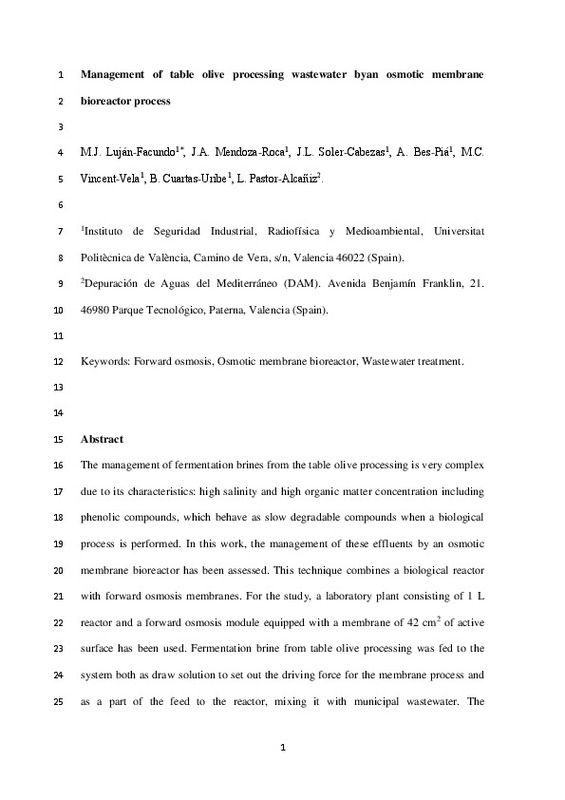JavaScript is disabled for your browser. Some features of this site may not work without it.
Buscar en RiuNet
Listar
Mi cuenta
Estadísticas
Ayuda RiuNet
Admin. UPV
Management of table olive processing wastewater by an osmotic membrane bioreactor process
Mostrar el registro sencillo del ítem
Ficheros en el ítem
| dc.contributor.author | Lujan Facundo, Maria Jose
|
es_ES |
| dc.contributor.author | Mendoza Roca, José Antonio
|
es_ES |
| dc.contributor.author | Soler-Cabezas, J. L.
|
es_ES |
| dc.contributor.author | Bes-Piá, M.A.
|
es_ES |
| dc.contributor.author | Vincent Vela, Maria Cinta
|
es_ES |
| dc.contributor.author | Cuartas Uribe, Beatriz Elena
|
es_ES |
| dc.contributor.author | Pastor-Alcaniz, L.
|
es_ES |
| dc.date.accessioned | 2021-11-18T12:50:56Z | |
| dc.date.available | 2021-11-18T12:50:56Z | |
| dc.date.issued | 2020-10-01 | es_ES |
| dc.identifier.issn | 1383-5866 | es_ES |
| dc.identifier.uri | http://hdl.handle.net/10251/177256 | |
| dc.description.abstract | [EN] The management of fermentation brines from the table olive processing is very complex due to its characteristics: high salinity and high organic matter concentration including phenolic compounds, which behave as slow degradable compounds when a biological process is performed. In this work, the management of these effluents by an osmotic membrane bioreactor has been assessed. This technique combines a biological reactor with forward osmosis membranes. For the study, a laboratory plant consisting of 1 L reactor and a forward osmosis module equipped with a membrane of 42 cm(2) of active surface has been used. Fermentation brine from table olive processing was fed to the system both as draw solution to set out the driving force for the membrane process and as a part of the feed to the reactor, mixing it with municipal wastewater. The experiments were carried out at a constant feed to microorganism ratio of 0.4 g COD.g SS-1.d(-1). Results indicated that the hypersaline effluent was able to produce the needed driving force by the process. Permeate fluxes ranged between 1 and 1.5 L.m(-2).h(-1) after the flux decay of the first operation days. Concerning the biological reaction, it has to be highlighted that phenols were eliminated after 24 days. Until that day, the biological process was jeopardized due to the quick increase of the conductivity in the reactor (ranging between 30 and 35 mS.cm(-1)), which was caused not only by the salinity of the influent but also by the reverse salt flux phenomenon. Soluble microbial products and extracted extracellular polymeric substances also increased in the reactor during the start-up. | es_ES |
| dc.description.sponsorship | This study was supported by the Spanish Ministry of Economy and Competitiveness through the project RTC-2015-3582-5-AR | es_ES |
| dc.language | Inglés | es_ES |
| dc.publisher | Elsevier | es_ES |
| dc.relation.ispartof | Separation and Purification Technology | es_ES |
| dc.rights | Reconocimiento - No comercial - Sin obra derivada (by-nc-nd) | es_ES |
| dc.subject | Forward osmosis | es_ES |
| dc.subject | Osmotic membrane bioreactor | es_ES |
| dc.subject | Wastewater treatment | es_ES |
| dc.subject.classification | INGENIERIA QUIMICA | es_ES |
| dc.title | Management of table olive processing wastewater by an osmotic membrane bioreactor process | es_ES |
| dc.type | Artículo | es_ES |
| dc.identifier.doi | 10.1016/j.seppur.2020.117075 | es_ES |
| dc.relation.projectID | info:eu-repo/grantAgreement/MINECO//RTC-2015-3582-5Q4618002BC.VALENCIANA/ES/Desarrollo de un proceso de biorreactor de membranas para gestión de efluentes salinos. Proyecto ODEON/ | es_ES |
| dc.rights.accessRights | Abierto | es_ES |
| dc.contributor.affiliation | Universitat Politècnica de València. Departamento de Ingeniería Hidráulica y Medio Ambiente - Departament d'Enginyeria Hidràulica i Medi Ambient | es_ES |
| dc.contributor.affiliation | Universitat Politècnica de València. Departamento de Ingeniería Química y Nuclear - Departament d'Enginyeria Química i Nuclear | es_ES |
| dc.description.bibliographicCitation | Lujan Facundo, MJ.; Mendoza Roca, JA.; Soler-Cabezas, JL.; Bes-Piá, M.; Vincent Vela, MC.; Cuartas Uribe, BE.; Pastor-Alcaniz, L. (2020). Management of table olive processing wastewater by an osmotic membrane bioreactor process. Separation and Purification Technology. 248:1-7. https://doi.org/10.1016/j.seppur.2020.117075 | es_ES |
| dc.description.accrualMethod | S | es_ES |
| dc.relation.publisherversion | https://doi.org/10.1016/j.seppur.2020.117075 | es_ES |
| dc.description.upvformatpinicio | 1 | es_ES |
| dc.description.upvformatpfin | 7 | es_ES |
| dc.type.version | info:eu-repo/semantics/publishedVersion | es_ES |
| dc.description.volume | 248 | es_ES |
| dc.relation.pasarela | S\414140 | es_ES |
| dc.contributor.funder | MINISTERIO DE ECONOMIA Y EMPRESA | es_ES |







![[Cerrado]](/themes/UPV/images/candado.png)

